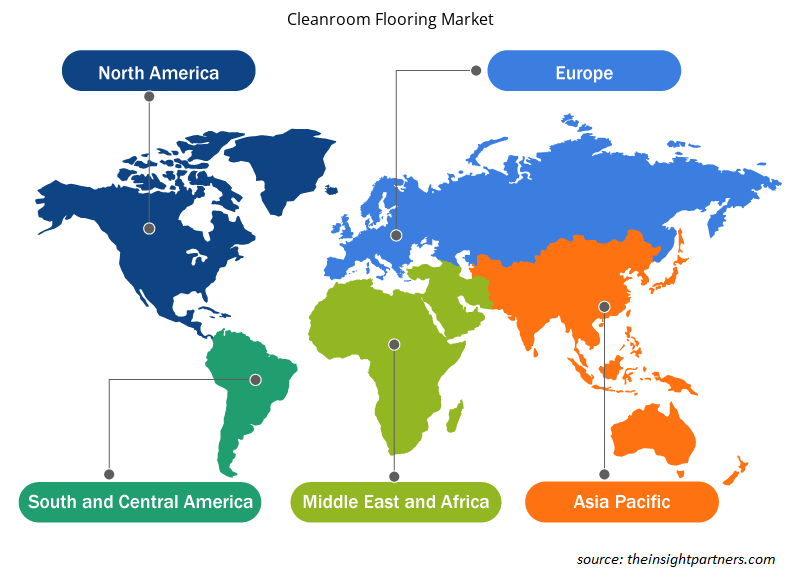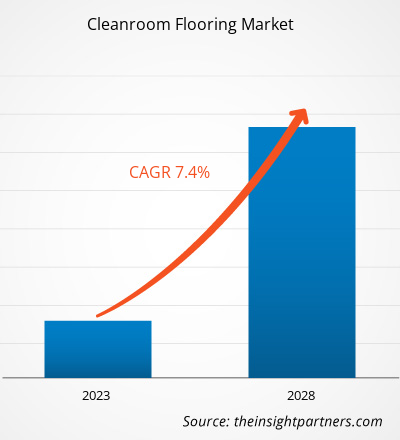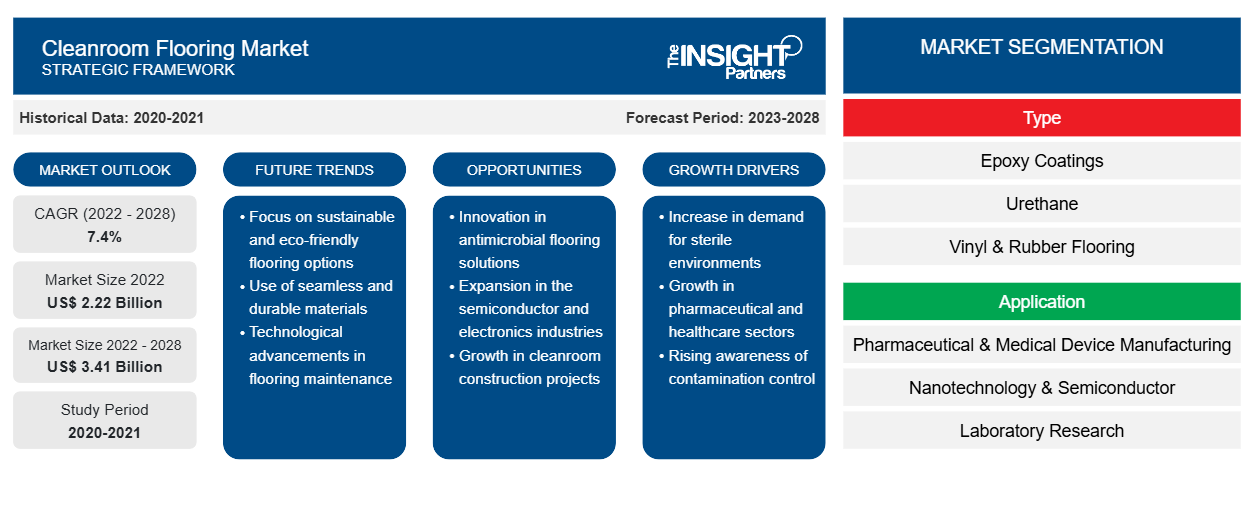Si prevede che il mercato delle pavimentazioni per camere bianche raggiungerà i 3.405,39 milioni di dollari entro il 2028; si stima che crescerà a un CAGR del 7,4% dal 2022 al 2028.
Una camera bianca si riferisce a un ambiente controllato con bassi livelli di inquinanti, come particelle, microrganismi, polvere e aerosol. I pavimenti per camere bianche sono utilizzati nei settori farmaceutico, elettronico e dei semiconduttori per evitare gli effetti potenzialmente dannosi dell'inquinamento atmosferico e delle particelle minuscole durante il processo di fabbricazione del prodotto. Il settore della tecnologia per camere bianche offre vari farmaci, articoli farmaceutici e attrezzature. La domanda di disinfezione degli ospedali sta aumentando rapidamente. La tecnologia per camere bianche ha attirato sempre più attenzione. La diffusione di virus e batteri nocivi è la ragione principale per promuovere la domanda di pavimenti per camere bianche.
Inoltre, normative sanitarie più severe, standard rigidi, domanda dei consumatori di prodotti di alta qualità, aumento della frequenza e della consapevolezza pubblica di malattie infettive e contagiose, aumento della necessità di farmaci e vaccini e ampliamento delle infrastrutture sanitarie stanno spingendo la crescita del mercato dei pavimenti per camere bianche . Inoltre, il crescente consumo di dispositivi elettronici di consumo in tutto il mondo sta guidando la domanda di semiconduttori. Inoltre, l'emergere dell'Internet of Things (IoT), dell'intelligenza artificiale (AI) e dell'apprendimento automatico (ML) sta offrendo opportunità di crescita al mercato dei semiconduttori, aiutando i chip di memoria a elaborare grandi quantità di dati in meno tempo. Le strutture di nanotecnologia e semiconduttori devono essere prive di polvere e particolato a causa della sensibilità delle operazioni tecnologiche. Le finiture del pavimento in queste strutture includono la presenza di una base di gola dal pavimento al muro senza linee di stucco e bordi delle piastrelle, creando un ambiente privo di polvere. Questi fattori stanno guidando il mercato per il segmento. Inoltre, la crescente domanda di chip di memoria avanzati e più veloci nelle applicazioni industriali sta stimolando la crescita del mercato dei semiconduttori.
Personalizza questo report in base alle tue esigenze
Riceverai la personalizzazione gratuita di qualsiasi report, comprese parti di questo report, o analisi a livello nazionale, pacchetto dati Excel, oltre a usufruire di grandi offerte e sconti per start-up e università
- Scopri le principali tendenze di mercato in questo rapporto.Questo campione GRATUITO includerà analisi di dati che spaziano dalle tendenze di mercato alle stime e alle previsioni.
Approfondimenti di mercato
La crescente domanda da parte delle industrie farmaceutiche ed elettroniche sta guidando la crescita del mercato dei pavimenti per camere bianche
I settori farmaceutici, di produzione di dispositivi medici e di scienze biologiche sono i settori tipici che utilizzano le camere bianche. Questi settori stanno riscontrando una domanda senza pari di kit per test diagnostici e materiali di consumo, dispositivi di protezione individuale, ventilatori medici e altre forniture mediche essenziali. La maggior parte di questi prodotti deve essere fabbricata in strutture prive di contaminazione, il che indica l'importanza delle camere bianche in questi settori. Inoltre, un aumento del numero di ospedali e centri chirurgici ambulatoriali sta spingendo la domanda di camere bianche, poiché devono mantenere al minimo il carico di particelle sospese nell'aria all'interno delle loro strutture. Diversi marchi leader di elettronica di consumo, tra cui Apple e Samsung, stanno effettuando enormi investimenti nel lancio di nuovi dispositivi per soddisfare la crescente domanda di dispositivi avanzati. Il settore dei semiconduttori in rapida crescita sta guidando la domanda di camere bianche, che, a sua volta, sta aiutando la crescita del mercato dei pavimenti per camere bianche.
Tipo Informazioni
In base al tipo, il mercato dei pavimenti per camere bianche è suddiviso in rivestimenti epossidici, pavimenti in uretano, vinile e gomma, pavimenti in metilmetacrilato e altri. Nel 2021, il segmento dei rivestimenti epossidici ha dominato il mercato. Un rivestimento epossidico è progettato per fornire un miglioramento estetico e una protezione a una superficie. Il vantaggio del rivestimento epossidico è il suo rivestimento denso, che ha una bassa porosità, rendendolo resistente e durevole sotto un traffico intenso e facile da pulire e mantenere. Può essere applicato in varie opzioni di colore e prestazioni che possono resistere a sostanze chimiche corrosive e dissipare l'elettricità statica. Questi vantaggi del rivestimento epossidico stanno guidando il mercato per il segmento.
Gerflor SAS, Easypharma SRL, Lindner AG, Forbo Flooring India Pvt Ltd. e Polyflor Ltd. sono tra i principali attori che operano nel mercato dei pavimenti per camere bianche. I principali attori adottano strategie come fusioni e acquisizioni e lanci di prodotti per espandere la loro presenza geografica e la base di consumatori.
Approfondimenti regionali sul mercato dei pavimenti per camere bianche
Le tendenze regionali e i fattori che influenzano il mercato dei pavimenti per camere bianche durante il periodo di previsione sono stati ampiamente spiegati dagli analisti di Insight Partners. Questa sezione discute anche i segmenti e la geografia del mercato dei pavimenti per camere bianche in Nord America, Europa, Asia Pacifico, Medio Oriente e Africa e Sud e Centro America.

- Ottieni i dati specifici regionali per il mercato dei pavimenti per camere bianche
Ambito del rapporto di mercato sui pavimenti per camere bianche
| Attributo del report | Dettagli |
|---|---|
| Dimensioni del mercato nel 2022 | 2,22 miliardi di dollari USA |
| Dimensioni del mercato entro il 2028 | 3,41 miliardi di dollari USA |
| CAGR globale (2022 - 2028) | 7,4% |
| Dati storici | 2020-2021 |
| Periodo di previsione | 2023-2028 |
| Segmenti coperti | Per tipo
|
| Regioni e Paesi coperti | America del Nord
|
| Leader di mercato e profili aziendali chiave |
|
Densità degli attori del mercato dei pavimenti per camere bianche: comprendere il suo impatto sulle dinamiche aziendali
Il mercato dei pavimenti per camere bianche sta crescendo rapidamente, spinto dalla crescente domanda degli utenti finali dovuta a fattori quali l'evoluzione delle preferenze dei consumatori, i progressi tecnologici e una maggiore consapevolezza dei vantaggi del prodotto. Con l'aumento della domanda, le aziende stanno ampliando le loro offerte, innovando per soddisfare le esigenze dei consumatori e capitalizzando sulle tendenze emergenti, il che alimenta ulteriormente la crescita del mercato.
La densità degli operatori di mercato si riferisce alla distribuzione di aziende o società che operano in un particolare mercato o settore. Indica quanti concorrenti (operatori di mercato) sono presenti in un dato spazio di mercato in relazione alle sue dimensioni o al valore di mercato totale.
Le principali aziende che operano nel mercato dei pavimenti per camere bianche sono:
- Tecnologia pulita AES Inc.
- Azienda Gerflor SAS
- Easypharma SRL
- Industrie delle camere bianche Sdn Bhd
- EP Pavimenti Corp
Disclaimer : le aziende elencate sopra non sono classificate secondo un ordine particolare.

- Ottieni una panoramica dei principali attori del mercato dei pavimenti per camere bianche
Segnala i riflettori
- Tendenze progressive nel settore delle pavimentazioni per camere bianche per aiutare gli operatori a sviluppare strategie efficaci a lungo termine
- Strategie di crescita aziendale adottate dalle aziende per garantire la crescita nei mercati sviluppati e in via di sviluppo
- Analisi quantitativa del mercato globale dei pavimenti per camere bianche dal 2020 al 2028
- Stima della domanda di pavimenti per camere bianche in vari settori
- Analisi delle cinque forze di Porter per illustrare l'efficacia degli acquirenti e dei fornitori che operano nel settore dei pavimenti per camere bianche
- Sviluppi recenti per comprendere lo scenario competitivo del mercato e la domanda di pavimenti per camere bianche
- Tendenze e prospettive di mercato, insieme ai fattori che regolano la crescita del mercato dei pavimenti per camere bianche
- Comprendere le strategie che sostengono l'interesse commerciale in relazione alla crescita del mercato, aiutando nel processo decisionale
- Dimensioni del mercato dei pavimenti per camere bianche in vari nodi del mercato
- Panoramica dettagliata e segmentazione del mercato, nonché dinamiche del settore
- Dimensioni del mercato dei pavimenti per camere bianche in varie regioni con promettenti opportunità di crescita
"Cleanroom Flooring Market Analysis to 2028" è uno studio specializzato e approfondito del settore dei prodotti chimici e dei materiali, incentrato sull'analisi delle tendenze di mercato. Il rapporto mira a fornire una panoramica del mercato con una segmentazione dettagliata. Il mercato dei pavimenti per camere bianche è segmentato in base a tipo, applicazione e geografia. In base al tipo, il mercato è segmentato in rivestimenti epossidici, uretano, pavimenti in vinile e gomma, pavimenti in metilmetacrilato e altri. In termini di applicazione, il mercato dei pavimenti per camere bianche è segmentato in produzione di dispositivi farmaceutici e medici, nanotecnologia e semiconduttori, ricerca di laboratorio e altri. In base alla geografia, il mercato è segmentato in cinque regioni principali: Nord America, Europa, Asia Pacifico, Medio Oriente e Africa e Sud e Centro America. Nel 2021, il Nord America ha dominato il mercato dei pavimenti per camere bianche e si prevede che la regione Asia Pacifico registrerà il CAGR più elevato nel mercato durante il periodo di previsione. Si prevede che fattori quali i crescenti investimenti in ricerca e sviluppo e l'aumento di nuovi studi di ricerca, come la terapia cellulare e la ricerca sulle cellule staminali, sosterranno la crescita del mercato delle pavimentazioni per camere bianche nei paesi dell'area Asia-Pacifico.
- Analisi storica (2 anni), anno base, previsione (7 anni) con CAGR
- Analisi PEST e SWOT
- Valore/volume delle dimensioni del mercato - Globale, Regionale, Nazionale
- Industria e panorama competitivo
- Set di dati Excel
Report recenti
Testimonianze
Motivo dell'acquisto
- Processo decisionale informato
- Comprensione delle dinamiche di mercato
- Analisi competitiva
- Analisi dei clienti
- Previsioni di mercato
- Mitigazione del rischio
- Pianificazione strategica
- Giustificazione degli investimenti
- Identificazione dei mercati emergenti
- Miglioramento delle strategie di marketing
- Aumento dell'efficienza operativa
- Allineamento alle tendenze normative





















 Ottieni un campione gratuito per - Mercato dei pavimenti per camere bianche
Ottieni un campione gratuito per - Mercato dei pavimenti per camere bianche